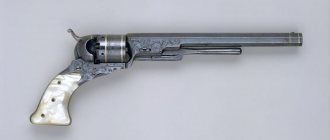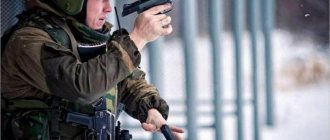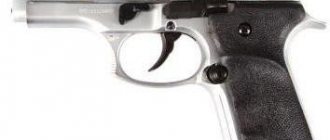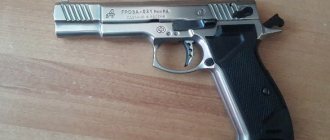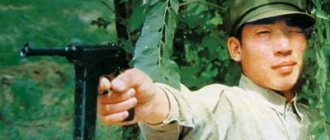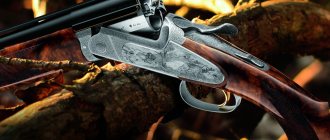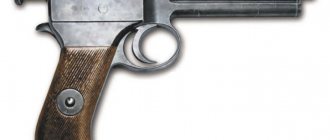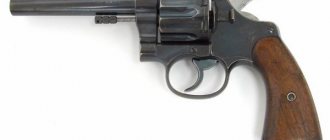A little bit of history
The C4 pistol was developed in the mid-60s of the last century. The weapon was created under the P3 (“Snake”) cartridge and its subsequent design modifications - P3A and P3AM. The caliber of these cartridges is 7.62 mm. The main feature of these ammunition is that they have a large thick-walled cartridge case (length 63 mm), and this, in turn, provides a huge muzzle energy of 120 J due to the larger charge of gunpowder, which is one third more than the muzzle energy of SP-type cartridges. 3. Another feature of these cartridges is that their bullet is almost completely recessed into the cartridge case, and only a small tip protrudes outward.
Double-barreled silent pistol C4
Subsequently, the C4 and C4M pistols became the basis for the creation of a new pistol - the SME.
World weapon legends. Le Ma double-barreled revolvers
A pistol capable of simultaneously conducting aimed fire and shooting buckshot
The original double-barreled revolver, combining rifled and smooth barrels, was developed and patented by French-American Jean Alexandre Le Mas in 1856. The first revolvers of his design were muzzle-loading and had primer ignition. The revolver had a 9-round drum with primer sockets in the rear, combined with a 0.42-inch (slightly more than 10mm) rifled barrel. A distinctive feature of this revolver was that another barrel served as the axis of the drum, which had a smooth (without rifling) 20-gauge bore and was designed to fire buckshot. Thus, Le Ma's revolver gave its owner a choice - to conduct targeted shooting from a rifled barrel, or to shoot "offhand" with buckshot at a short distance, when there is no time or opportunity to aim accurately.
The choice of barrel for firing was ensured by a swinging striker located on the trigger, which had a switch lever for installing the striker opposite the primer in the drum (upper barrel) or in the frame (lower barrel).
Revolvers of the LeMa system were produced in small quantities in the USA, as well as in Belgium and France. They managed to fight in the American Civil War on the side of the Confederates.
With the massive transition from capsule muzzle-loading systems to weapons chambered for unitary cartridges, Le Ma revolvers retained their popularity for some time. Belgian and French companies produced variations on the theme of Le Ma's 1871 patent until the eighties of the 19th century. As a rule, the caliber of the rifled barrel varied from 9 to 12 mm, the central smooth barrel could have 20 or 16 gauge. There were models both chambered for pin-fire cartridges and for more modern centerfire cartridges.
LeMa's early muzzle-loading revolvers, as their name suggests, were loaded from the front - through the muzzle of the chambers in the drums and through the central barrel. The primers were placed on bushings on the drum and on the frame, with the hammer cocked. A special lever was attached to the left side of the frame for sending bullets into the drum and ramrod.
Given the location of the central barrel, in versions chambered for a unitary cartridge, its reloading required partial disassembly of the weapon - the upper part of the frame with the barrels was attached to the lower part with a screw. The drum could be reloaded without disassembling the revolver, for which there was a special hinged door on the right side of the frame. To remove spent cartridges from the drum, a cleaning rod was used on the right side of the frame.
By the beginning of the 20th century, the idea of a double-barreled revolver had almost completely become obsolete, but the growing popularity of historical weapons from the American Civil War, which began in the second half of the 20th century, led to the fact that a number of companies in Italy and the USA are currently producing replicas of this system. The original LeMa revolvers, especially from the Civil War, are now available only to very wealthy collectors and usually have a price of at least 10 thousand dollars.
Weapon design and principle of operation
The weapon has a rather interesting design, not similar to the standard design of pistols. It is more like a sideflint design.
Design
The silent pistol has a double-barreled design, in which the barrels are assembled into a single block and placed one above the other in a vertical plane. The pistol is not self-loading. To load and unload weapons, special 2-round clips made of metal are used.
Design of the CM4 pistol
Single action trigger. The cocking process is carried out using a special lever, which is located in the pistol grip. The figure shows how the cocking process is performed.
Cocking the CM4 pistol
The safety is located at the top left side of the pistol grip. On the reverse side of the trigger there is a latch for the pistol barrel block.
The pistol sight is open.
Operating principle
The recommended shooting distance was about 10-12 meters. According to the designers, it was necessary to hit/neutralize the target with the first shot, and to fire the so-called “control shot to the head” with the second shot. As for the sound of the shot, there was none at all, but only the characteristic clicks of the triggers hitting the firing pins were heard.
Cartridge SP3
The 7.62x63 mm pistol cartridge looked very much like the 1943 model cartridge, because it had a 7S62 bullet and had a completely acceptable penetration effect. Quiet shooting was ensured by the design of a special cartridge used in weapons. Inside the cartridge case, between the powder charge and the bullet, there is a piston consisting of a piston and a telescopic rod. When the gunpowder is ignited by the primer, a piston moves and pushes the bullet out. That, in turn, passes through a rather short barrel with 6 grooves and stabilizes at the exit from the barrel. Sealing of powder gases is ensured by deformation of the cartridge case when the piston moves (it practically levels out and becomes cylindrical). This eliminates the sound and flame of the shot.
Design of cartridge SP3
Mannlicher, model 1903
Like many other companies involved in the production of self-loading pistols, the management understood that such weapons were the future in military affairs. Therefore, all his efforts were aimed at creating weapons that fired powerful cartridges and had a pre-cocking system. The presented Mannlicher 1903 refers specifically to this type of pistol. The hidden hammer was cocked when the bolt was pulled back using a lever that can be seen in the upper part of the body. When the shutter is released, then, moving forward, ...
Read more
Application
As for the practical use of weapons, there is no information or facts.
It is reliably known that the C4 pistol and its modification were in service with army special forces and KGB forces.
Sectional view of P3AM cartridge
After the collapse of the Soviet Union, a certain number of S4Ms still remained in service. Today their fate is unknown.
Mannlicher, model 1901
The Steyer factory began producing self-loading pistols in 1894, and the first was a pistol made according to the design of Ferdinand Ritter von Mannlicher, a German who lived in Austria and became known for his excellent military rifles. Over the course of several years, several more variants of the pistol were produced (the 1901 model is shown here). Naturally, weapons produced in a factory with such a reputation as Steyer's were of high quality. Pistols with a recoil delay mechanism were mainly produced...
Read more
Options, modifications of the pistol
In total, 2 versions of this type of pistol were created, the second of them was a modification of the first. The options are as follows:
- pistol C4 - the original model of a pistol chambered for 7.62x63 mm;
- S4M pistol is a modification of the original version chambered for the new P3AM cartridge with a modified cartridge case.
S4 pistol and P3 cartridges
The S4 pistol became the basis for the creation of a new silent pistol SME.
Unknown France: where there are twenty, there are thirty
It so happened that unknown European masters are confidently pushing aside the Americans in our top revolver. The first place in our ranking with thirty pin cartridges in the drum belongs to the product of an unnamed master, presumably working in France at the end of the 19th century.
In concept, this revolver is similar to the previous one - the same two barrels and cartridges in the drum in two concentric rows. There is, however, a difference - the outer row holds 20 rounds, while the inner row holds only 10. Despite the impressive capacity, the dimensions of the revolver are not that large due to the relatively small caliber - only 5.6 mm.
Steyer, model 1912
As for short-barreled weapons, at the beginning of the 20th century it concentrated all its efforts on the production of a self-loading army pistol, and the result was the Model 1912 pistol shown in this photo. This weapon is very similar in appearance to the famous self-loading Colt of the previous year. It has the same heavy bolt, with a barrel inside that covers almost the entire frame. When the bolt is in the forward position, two protrusions-hooks on the breech of the barrel fall into their corresponding slots...
Read more
Pistol FORT-12R (RM)
Since 1999, it has been produced by KNPO Fort of the Ministry of Internal Affairs of Ukraine (Vinnitsa), an enterprise whose main specialization is the production of firearms and various special equipment for law enforcement officers and other security agencies.
Models produced before 2010 had no quality problems and you can still find new pistols from older years, as well as commissions in excellent condition.
The price of a new pistol in a store is about 16 thousand UAH, a used pistol in excellent condition is about 7 thousand UAH.
Models produced from 2010 to the present day may have defects, so when choosing a gun store, it is better to go with someone who is well versed in traumatic weapons.
In general, the pistol is reliable; in most cases, maintenance and repair do not require contacting specialized workshops.
Characteristics:
- Caliber 9 mm R.A.
- Barrel length 95 mm
- Gun length 180 mm
- Gun height 131 mm
- Gun width 32 mm
- Weight of the pistol with magazine without cartridges 0.83 kg
- Effective range 5-7 meters
- Practical rate of fire 40 rounds/min.
- Initial bullet departure speed 320 m/s (maximum, for a certified cartridge)
- Magazine capacity, cartridges 12 pcs.
- Double action (SA/DA) trigger mechanism
Browning Model 1900 (old model)
John Moses Browning's first successful invention was the machine gun, manufactured and adopted by the US Navy in 1898. Two years later, Browning developed the self-loading pistol shown here. However, after disagreements with Winchester, with whom he worked together for several years, Browning came to the conclusion that his self-loading pistols would be in better demand in Europe than in America. And he turned out to be right: the big one in Liege showed extreme interest...
Read more
Roth-Steyer, model 1907
This pistol went into mass production in 1907, when it was adopted by the Austro-Hungarian army, mainly for cavalry use. This was the first time that a self-loading pistol instead of a revolver entered service in the country. The Roth-Steyer pistol had a pre-cocking system, and it was a rather unusual type of mechanism. The bolt is very long, the back is solid except for the firing pin groove, but the front is hollow and its diameter allows the bolt to fit snugly against...
Read more
Browning .32 caliber (7.65 mm) Model 1910
After acquiring Browning's patents, the Model 1910 pistol was developed, which was initially chambered for the 7.65 x 17 mm Browning cartridge, but was later chambered for the 9 x 17 mm cartridge. This weapon uses the recoil principle of a free bolt, and its recoil spring is located on the barrel and locked in the casing with a special coupling, as a result of which the appearance of the pistol is quite unusual and easily recognizable. On the handle of the weapon there is a safety key in the form of a key. The Model 1910 was not a success with the military, although...
Read more
1 more >
Appearance of the Landstad automatic revolver
Frankly speaking, it is very difficult to call an automatic revolver made by a Norwegian designer a revolver. Yes, it has a drum, yes, it rotates, but you still get the impression that it’s not a revolver, but not a pistol either. But first things first.
The appearance of the weapon is quite ordinary for its time: a massive frame and a thin curved handle, the only thing that does not fit into the overall picture is the flat drum and an overly massive pile of parts where the weapon’s bolt should have been.
Behind the flat drum with two chambers there is a bolt and two platforms for a more comfortable grip for operating it. Directly in front of the platforms for holding the bolt of the weapon there is a rod connecting the trigger and the drum of the weapon. At the bottom of the revolver handle on the left side there is a cutout in the wooden plate in which the button is located. With its help, the handle opens for installing a magazine into it. It is strange that the designer, when creating a new weapon, did not provide for the possibility of replacing the magazine in a way more familiar to modern people - from the bottom of the handle. Giving preference to the shape of a revolver handle for the sake of convenience and speed of reloading and at the same time using a completely modern magazine is a very controversial decision. And yes, don’t think, the author of the article is not crazy and is absolutely sober, this weapon really has both a drum and a magazine, but more details about the design below.
The sighting devices are non-adjustable rear sight and front sight; the weapon does not have safety devices, although their presence would not be superfluous in this case.

